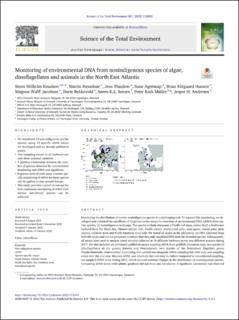| dc.description.abstract | Monitoring the distribution of marine nonindigenous species is a challenging task. To support this monitoring, we developed and validated the specificity of 12 primer-probe assays for detection of environmental DNA (eDNA) from marine species, all nonindigenous to Europe. The species include sturgeons, a Pacific red algae, oyster thief, a freshwater hydroid from the Black Sea, Chinese mitten crab, Pacific oyster, warty comb jelly, sand gaper, round goby, pink salmon, rainbow trout and North American mud crab. We tested all assays in the laboratory, on DNA extracted from both the target and non-target species to ensure that they only amplified DNA from the intended species. Subsequently, all assays were used to analyse water samples collected at 16 different harbours across two different seasons during 2017. We also included six previously published assays targeting eDNA from goldfish, European carp, two species of dinoflagellates of the genera Karenia and Prorocentrum, two species of the heterokont flagellate genus Pseudochattonella. Conventional monitoring was carried out alongside eDNA sampling but with only one sampling event over the one year. Because eDNA was relatively fast and easy to collect compared to conventional sampling, we sampled eDNA twice during 2017, which showed seasonal changes in the distribution of nonindigenous species. Comparing eDNA levels with salinity gradients did not show any correlation. A significant correlation was observed between number of species detected with conventional monitoring methods and number of species found using eDNA at each location. This supports the use of eDNA for surveillance of the distribution of marine nonindigenous species, where the speed and relative easy sampling in the field combined with fast molecular analysis may provide advantages compared to conventional monitoring methods. Prior validation of assays increases taxonomic precision, and laboratorial setup facilitates analysis of multiple samples simultaneously. The specific eDNA assays presented here can be implemented directly in monitoring programmes across Europe and potentially worldwide to infer a more precise picture of the dynamics in the distribution of marine nonindigenous species. | en_US |

